Sugar Content and Warning Criteria Evaluation for Popular Sugar-Sweetened Beverages in Taipei, Taiwan
Abstract
1. Introduction
2. Materials and Methods
2.1. Data Collection
2.2. Coding Procedures
2.3. Nutrition Labels of SSBs
2.4. Energy and Sugar Criteria for SSBs
2.5. Coding Reliability and Data Analyses
3. Results
Nutrition Content, Serving Size, and Portion Size
4. Discussion
5. Conclusions
Author Contributions
Funding
Acknowledgments
Conflicts of Interest
Appendix A
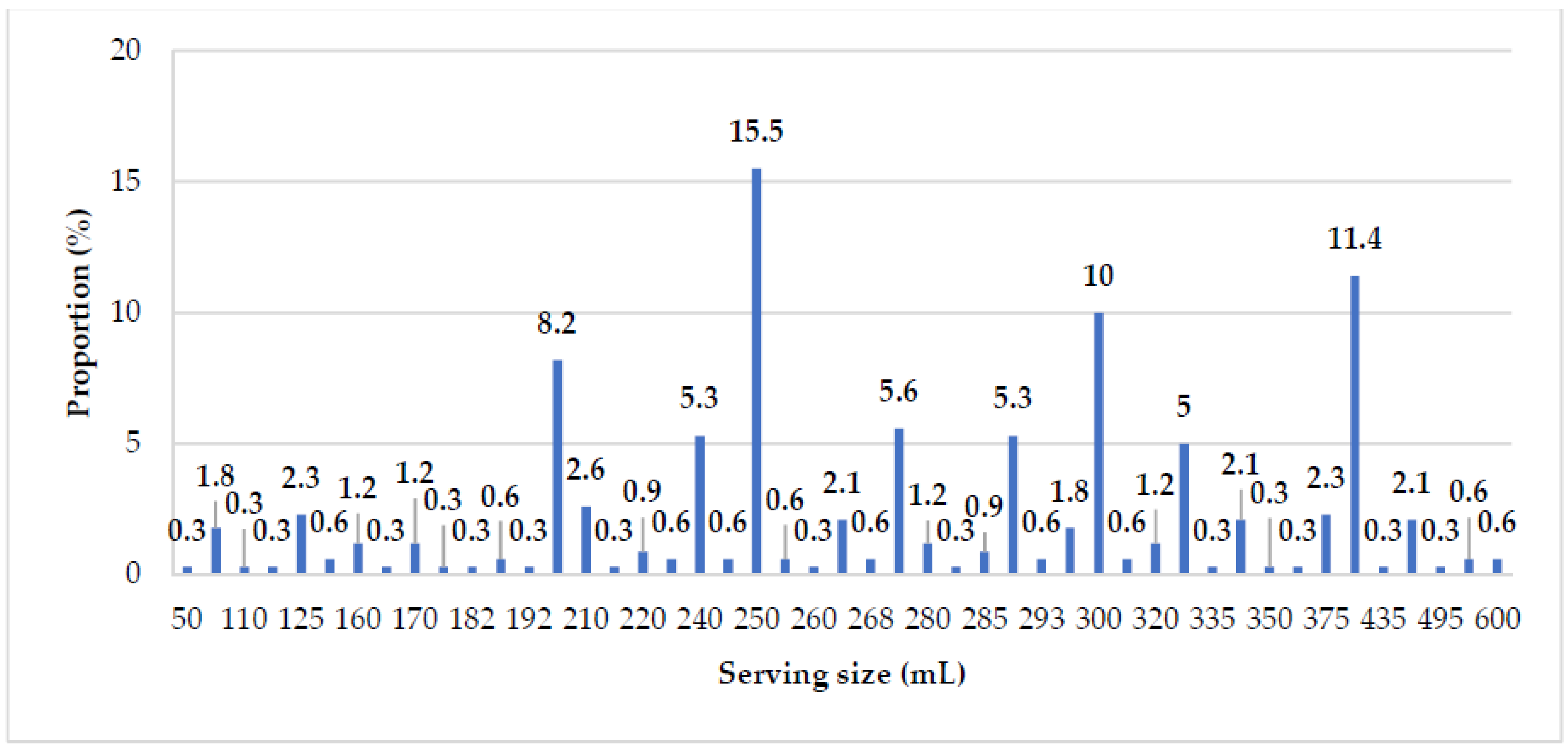
References
- Tedstone, A.; Lund, V.; Sanderson, P.; Pyne, V.; Lynas, J.; Stolte, H.; Reddy, S.; Stone, E.; Marklew, R.; Ha, M.-A. Carbohydrates and Health; The Stationary Office: London, UK, 2015. [Google Scholar]
- Turck, D.; Bohn, T.; Castenmiller, J.; de Henauw, S.; Hirsch-Ernst, K.I.; Knutsen, H.K.; Maciuk, A.; Mangelsdorf, I.; McArdle, H.J.; Naska, A.; et al. Tolerable upper intake level for dietary sugars. EFSA J. 2022, 20, e07074. [Google Scholar] [PubMed]
- Ministry of Health and Welfare. Nutrition and Health Survey in Taiwan: 2013–2016. Available online: https://www.hpa.gov.tw/Pages/Detail.aspx?nodeid=3999&pid=11145 (accessed on 18 July 2022).
- WHO. Guideline: Sugars Intake for Adults and Children. Available online: http://www.who.int/nutrition/publications/guidelines/sugars_intake/en/ (accessed on 18 July 2022).
- Hawkes, C.; Smith, T.G.; Jewell, J.; Wardle, J.; Hammond, R.A.; Friel, S.; Thow, A.M.; Kain, J. Smart food policies for obesity 436 prevention. Lancet 2015, 385, 2410–2421. [Google Scholar] [CrossRef]
- Wartella, E.A.; Lichtenstein, A.H.; Boon, C.S. Front-of-Package Nutrition Rating Systems and Symbols: Phase I Report; National Academies Press: Washington, DC, USA, 2010. [Google Scholar]
- World Health Organization. Technical Meeting on Nutrition Labelling for Promoting Healthy Diets; World Health Organization: Geneva, Switzerland, 2015.
- European Food Information Council. Global Update on Nutritional Labelling. Available online: https://www.eufic.org/images/uploads/files/GUNL-2017-exsummary.pdf (accessed on 18 July 2022).
- Corvalán, C.; Reyes, M.; Garmendia, M.L.; Uauy, R. Structural responses to the obesity and non-communicable diseases epidemic: Update on the Chilean law of food labelling and advertising. Obes. Rev. 2019, 20, 367–374. [Google Scholar] [CrossRef]
- Ministry of Health. Amend Supreme Decree No. 977, of 1996, Food Sanitary Regulations. Available online: https://www.leychile.cl/Navegar?idNorma=1078836 (accessed on 18 July 2022).
- World Cancer Research Fund. Nutrition Label Standards and Regulations on the Use of Claims and Implied Claims on Food; World Cancer Research Fund: London, UK, 2019; Available online: https://www.wcrf.org/sites/default/files/Nutrition-labels.pdf (accessed on 18 July 2022).
- California State Legislature. SB-203 Sugar-Sweetened Beverages: Safety Warnings. Available online: http://leginfo.legislature.ca.gov/faces/billTextClient.xhtml?bill_id=201520160SB203 (accessed on 18 July 2022).
- Reyes, M.; Smith Taillie, L.; Popkin, B.; Kanter, R.; Vandevijvere, S.; Corvalán, C. Changes in the amount of nutrient of packaged foods and beverages after the initial implementation of the Chilean Law of Food Labelling and Advertising: A nonexperimental prospective study. PLoS Med. 2020, 17, e1003220. [Google Scholar] [CrossRef] [PubMed]
- Scarborough, P.; Adhikari, V.; Harrington, R.A.; Elhussein, A.; Briggs, A.; Rayner, M.; Adams, J.; Cummins, S.; Penney, T.; White, M. Impact of the announcement and implementation of the UK Soft Drinks Industry Levy on sugar content, price, product size and number of available soft drinks in the UK, 2015–2019: A controlled interrupted time series analysis. PLoS Med. 2020, 17, e1003025. [Google Scholar] [CrossRef] [PubMed]
- Global Food Research Program, The University of North Carolina at Chapel Hill. Front-of-Package (FOP) Labeling: Empowering Consumers to Make Healthy Choices. Available online: https://www.globalfoodresearchprogram.org/wp-content/uploads/2021/10/FOP_Factsheet_UNCGFRP.pdf (accessed on 18 July 2022).
- Paraje, G.; Colchero, A.; Wlasiuk, J.M.; Sota, A.M.; Popkin, B.M. The effects of the Chilean food policy package on aggregate employment and real wages. Food Policy 2021, 100, 102016. [Google Scholar] [CrossRef]
- Jacobs, A. In Sweeping War on Obesity, Chile Slays Tony the Tiger. Available online: https://www.nytimes.com/2018/02/07/health/obesity-chile-sugar-regulations.html (accessed on 18 July 2022).
- Taillie, L.S.; Hall, M.G.; Popkin, B.M.; Ng, S.W.; Murukutla, N. Experimental Studies of Front-of-Package Nutrient Warning Labels on Sugar-Sweetened Beverages and Ultra-Processed Foods: A Scoping Review. Nutrients 2020, 12, 569. [Google Scholar] [CrossRef]
- Chepulis, L.; Mearns, G.; Hill, S.; Wu, J.H.; Crino, M.; Alderton, S.; Jenner, K. The nutritional content of supermarket beverages: A cross-sectional analysis of New Zealand, Australia, Canada and the UK. Public Health Nutr. 2018, 21, 2507–2516. [Google Scholar] [CrossRef] [PubMed]
- Guelinckx, I.; Iglesia, I.; Bottin, J.H.; De Miguel-Etayo, P.; González-Gil, E.M.; Salas-Salvadó, J.; Kavouras, S.A.; Gandy, J.; Martinez, H.; Bardosono, S.; et al. Intake of water and beverages of children and adolescents in 13 countries. Eur. J. Nutr. 2015, 54, 69–79. [Google Scholar] [CrossRef] [PubMed]
- Özen, A.E.; Bibiloni, M.M.; Pons, A.; Tur, J.A. Fluid intake from beverages across age groups: A systematic review. J. Hum. Nutr. Diet. 2015, 28, 417–442. [Google Scholar] [CrossRef] [PubMed]
- Hashem, K.M.; He, F.J.; Jenner, K.H.; MacGregor, G.A. Cross-sectional survey of the amount of free sugars and calories in carbonated sugar-sweetened beverages on sale in the UK. BMJ Open 2016, 6, e010874. [Google Scholar] [CrossRef] [PubMed]
- Chepulis, L.; Mearns, G.J.; Skinner, K. Sugar content of supermarket beverages commonly consumed by children in New Zealand. Aust. N. Z. J. Public Health 2017, 41, 321–322. [Google Scholar] [CrossRef] [PubMed][Green Version]
- Brownbill, A.L.; Miller, C.L.; Braunack-Mayer, A.J. Industry use of ‘better-for-you’ features on labels of sugar-containing beverages. Public Health Nutr. 2018, 21, 3335–3343. [Google Scholar] [CrossRef] [PubMed]
- Department of Health. Health Star Rating Style Guide. Available online: http://www.healthstarrating.gov.au/internet/healthstarrating/publishing.nsf/Content/style-guide (accessed on 18 July 2022).
- Ministry of Economic Affairs. CNS Catalog. Available online: https://www.bsmi.gov.tw/wSite/public/Data/f1583306945288.pdf (accessed on 18 July 2022).
- Ministry of Economic Affairs. Industrial Product Classification. Available online: https://www.moea.gov.tw/Mns/dos/content/ContentLink.aspx?menu_id=20444 (accessed on 18 July 2022).
- Ministry of Health and Welfare. Act Governing Food Safety and Sanitation. Available online: https://law.moj.gov.tw/ENG/LawClass/LawAll.aspx?pcode=L0040001 (accessed on 18 July 2022).
- Popkin, B.; Armstrong, L.E.; Bray, G.M.; Caballero, B.; Frei, B.; Willett, W.C. A new proposed guidance system for beverage consumption in the United States. Am. J. Cli. Nutr. 2006, 83, 529–542. [Google Scholar] [CrossRef]
- Essman, M.; Popkin, B.M.; Corvalán, C.; Reyes, M.; Taillie, L.S. Sugar-Sweetened Beverage Intake among Chilean Preschoolers and Adolescents in 2016: A Cross-Sectional Analysis. Nutrients 2018, 10, 1767. [Google Scholar] [CrossRef]
- Ministry of Health and Welfare. Recommendation of Food Serving Size. Available online: https://consumer.fda.gov.tw/Law/Detail.aspx?nodeID=518&lawid=588 (accessed on 18 July 2022).
- Ministry of Health and Welfare. Regulations on Nutrition Label of Food Package. Available online: https://consumer.fda.gov.tw/Law/Detail.aspx?nodeID=518&lawid=587 (accessed on 18 July 2022).
- Sim, J.; Wright, C.C. The kappa statistic in reliability studies: Use, interpretation, and sample size requirements. Phys. Ther. 2005, 85, 257–268. [Google Scholar] [CrossRef] [PubMed]
- Menu, A.M. Australian Health Survey: Nutrition First Results—Foods and Nutrients; Australian Bureau of Statistics: Canberra, Australia, 2011.
- Almiron-Roig, E.; Forde, C.G.; Hollands, G.; Vargas, M.; Brunstrom, J. A review of evidence supporting current strategies, challenges, and opportunities to reduce portion sizes. Nutr. Rev. 2020, 78, 91–114. [Google Scholar] [CrossRef] [PubMed]
- Smith, N.R.; Grummon, A.H.; Frerichs, L.M. Demographic Groups Likely Affected by Regulating Sugar-Sweetened Beverage Portion Sizes. Am. J. Prev. Med. 2020, 59, e135–e139. [Google Scholar] [CrossRef] [PubMed]
- Crino, M.; Herrera, A.M.M.; Ananthapavan, J.; Wu, J.H.Y.; Neal, B.; Lee, Y.Y.; Zheng, M.; Lal, A.; Sacks, G. Modelled Cost- Effectiveness of a Package Size Cap and a Kilojoule Rreduction Intervention to Reduce Energy Intake from Sugar-Sweetened Beverages in Australia. Nutrients 2017, 9, 983. [Google Scholar] [CrossRef] [PubMed]
- Wen, J.; Ma, H.; Yu, Y.; Zhang, X.; Guo, D.; Yin, X.; Yu, X.; Yin, N.; Wang, J.; Zhao, Y. Sugar Content of Market Beverages and Children’s Sugar Intake from Beverages in Beijing, China. Nutrients 2021, 13, 4297. [Google Scholar] [CrossRef]
- Haskelberg, H.; Neal, B.; Dunford, E.; Flood, V.; Rangan, A.; Thomas, B.; Cleanthous, X.; Trevena, H.; Zheng, J.M.; Louie, J.C.Y.; et al. High variation in manufacturer-declared serving size of packaged discretionary foods in Australia. Br. J. Nutr. 2016, 115, 1810–1818. [Google Scholar] [CrossRef] [PubMed]
- Chen, M.C.; Chien, Y.W.; Yang, H.T.; Chen, Y.C. Marketing strategy, serving size, and nutrition information of popular children’s food packages in Taiwan. Nutrients 2019, 11, 174. [Google Scholar] [CrossRef] [PubMed]
- Roberto, C.; Khandpur, N. Improving the design of nutrition labels to promote healthier food choices and reasonable portion sizes. Int. J. Obes. 2014, 38, S25–S33. [Google Scholar] [CrossRef]
- Vanderlee, L.; Goodman, S.; Sae Yang, W.; Hammond, D. Consumer understanding of calorie amounts and serving size: Implications for nutritional labelling. Can. J. Public Health 2012, 103, e327–e331. [Google Scholar] [CrossRef] [PubMed]
- Zhang, Y.; Kantor, M.A.; Juan, W. Usage and Understanding of Serving Size Information on Food Labels in the United States. Am. J. Health Promot. 2016, 30, 181–187. [Google Scholar] [CrossRef] [PubMed]
- Health Canada. Food Labelling Changes. Available online: https://www.canada.ca/en/health-canada/services/food-labelling-changes.html (accessed on 18 July 2022).
- U.S. Food & Drug Administration. Changes to the Nutrition Facts Label. Available online: https://www.fda.gov/food/food-labeling-nutrition/changes-nutrition-facts-label (accessed on 18 July 2022).
- Rippin, H.L.; Hutchinson, J.; Jewell, J.; Breda, J.J.; Cade, J.E. Comparison of consumed portion sizes and on-pack serving sizes of UK energy dense foods. Appetite 2019, 134, 193–203. [Google Scholar] [CrossRef] [PubMed]
- Ministry of Health and Welfare. Regulation for the Labeling of Freshly Made Beverages in Chain Drink Stores, Convenience Stores, and Fast Food Restaurants. Available online: https://www.fda.gov.tw/ENG/lawContent.aspx?cid=16&id=3422 (accessed on 17 July 2022).
- Khandpur, N.; de Morais Sato, P.; Mais, L.A.; Bortoletto Martins, A.P.; Spinillo, C.G.; Garcia, M.T.; Urquizar Rojas, C.F.; Jaime, P.C. Are front-of-package warning labels more effective at communicating nutrition information than traffic-light labels? A randomized controlled experiment in a Brazilian sample. Nutrients 2018, 10, 688. [Google Scholar] [CrossRef] [PubMed]
- Ashdown-Franks, G.; Vancampfort, D.; Firth, J.; Smith, L.; Sabiston, C.M.; Stubbs, B.; Koyanagi, A. Association of leisure-time sedentary behavior with fast food and carbonated soft drink consumption among 133,555 adolescents aged 12–15 years in 44 low- and middle-income countries. Int. J. Behav. Nutr. Phys. Act. 2019, 16, 1–11. [Google Scholar] [CrossRef]
- Ding, M.; Bhupathiraju, S.N.; Satija, A.; Van Dam, R.M.; Hu, F.B. Long-term coffee consumption and risk of cardiovascular disease: A systematic review and a dose-response meta-analysis of prospective cohort studies. Circulation 2014, 129, 643–659. [Google Scholar] [CrossRef] [PubMed]
- Yi, M.; Wu, X.; Zhuang, W.; Xia, L.; Chen, Y.; Zhao, R.; Wan, Q.; Du, L.; Zhou, Y. Tea Consumption and Health Outcomes: Umbrella Review of Meta-Analyses of Observational Studies in Humans. Mol. Nutr. Food Res. 2019, 63, e1900389. [Google Scholar] [CrossRef]
- Khan, N.; Mukhtar, H. Tea polyphenols in promotion of human health. Nutrients 2018, 11, 39. [Google Scholar] [CrossRef] [PubMed]
- Grosso, G.; Godos, J.; Galvano, F.; Giovannucci, E.L. Coffee, caffeine, and health outcomes: An Umbrella Review. Annu. Rev. Nutr. 2017, 37, 131–156. [Google Scholar] [CrossRef]
- Shih, Y.H.; Chang, H.Y.; Wu, H.C.; Stanaway, F.F.; Pan, W.H. High sugar-sweetened beverage intake frequency is associated with smoking, irregular meal intake and higher serum uric acid in Taiwanese adolescents. J. Nutr. Sci. 2020, 9, e7. [Google Scholar] [CrossRef]
- Ng, S.W.; Ostrowski, J.D.; Li, K.P. Trends in added sugars from packaged beverages available and purchased by US households, 2007–2012. Am. J. Clin. Nutr. 2017, 106, 179–188. [Google Scholar] [CrossRef]
- Shih, Y.-H.; Wu, H.-C.; Pan, W.-H.; Chang, H.-Y. Increased coffee, tea, or other sugar-sweetened beverage consumption in adolescents is associated with less satisfactory dietary quality, body fatness and serum uric acid profiles over the past 18 years in Taiwan. Asia Pac. J. Clin. Nutr. 2019, 28, 371–382. [Google Scholar] [PubMed]
- Parker, C.E.; Vivian, W.J.; Oddy, W.H.; Beilin, L.J.; Mori, T.A.; O’Sullivan, T.A. Changes in dairy food and nutrient intakes in Australian adolescents. Nutrients 2012, 4, 1794–1811. [Google Scholar] [CrossRef]
- Mozaffarian, D.; Wu, J.H.Y. Flavonoids, dairy foods, and cardiovascular and metabolic health: A review of emerging biologic pathways. Circ. Res. 2018, 122, 369–384. [Google Scholar] [CrossRef] [PubMed]
- Elwood, P.C.; Pickering, J.E.; Givens, D.I.; Gallacher, J.E. The consumption of milk and dairy foods and the incidence of vascular disease and diabetes: An overview of the evidence. Lipids 2010, 45, 925–939. [Google Scholar] [CrossRef] [PubMed]
- Ministry of Health and Welfare. Reports of The Nutrition and Health Survey in Taiwan 2017–2020 (NAHSIT 2017–2020). Available online: https://www.hpa.gov.tw/Pages/Detail.aspx?nodeid=3999&pid=15562&sid=11145 (accessed on 18 July 2022).
- Ministry of Health and Welfare. Dietary Guidelines. Available online: https://www.hpa.gov.tw/Pages/EBook.aspx?nodeid=1208 (accessed on 18 July 2022).
- Comerford, K.B.; Miller, G.D.; Boileau, A.C.; Masiello Schuette, S.N.; Giddens, J.C.; Brown, K.A. Global review of dairy recommendations in food-based dietary guidelines. Front. Nutr. 2021, 8, 671999. [Google Scholar] [CrossRef]
- Patel, A.I.; Moghadam, S.D.; Freedman, M.; Hazari, A.; Fang, M.-L.; Allen, I.E. The association of flavored milk consumption with milk and energy intake, and obesity: A systematic review. Prev. Med. 2018, 111, 151–162. [Google Scholar] [CrossRef] [PubMed]
- Mahato, D.K.; Keast, R.; Liem, D.G.; Russell, C.G.; Cicerale, S.; Gamlath, S. Sugar reduction in dairy food: An overview with flavoured milk as an example. Foods 2020, 9, 1400. [Google Scholar] [CrossRef] [PubMed]
- Kanter, R.; Reyes, M.; Vandevijvere, S.; Swinburn, B.; Corvalán, C. Anticipatory effects of the implementation of the Chilean Law of Food Labeling and Advertising on food and beverage product reformulation. Obes. Rev. 2019, 20, 129–140. [Google Scholar] [CrossRef] [PubMed]
- Collin, L.J.; Judd, S.; Safford, M.; Vaccarino, V.; Welsh, J.A. Association of Sugary Beverage Consumption With Mortality Risk in US Adults: A Secondary Analysis of Data From the REGARDS Study. JAMA Netw. Open 2019, 2, e193121. [Google Scholar] [CrossRef]
- Heyman, M.B.; Abrams, S.A. Section on Gastroenterology, Hepatology, and Nutrition; Committee on Nutrition. Fruit Juice in Infants, Children, and Adolescents: Current Recommendations. Pediatrics 2017, 139, e20170967. [Google Scholar] [CrossRef]
- Auerbach, B.J.; Dibey, S.; Vallila-Buchman, P.; Kratz, M.; Krieger, J. Review of 100% Fruit Juice and Chronic Health Conditions: Implications for Sugar-Sweetened Beverage Policy. Adv. Nutr. 2018, 9, 78–85. [Google Scholar] [CrossRef]
- D’Elia, L.; Dinu, M.; Sofi, F.; Volpe, M.; Strazzullo, P.; SINU Working Group. Endorsed by SIPREC 100% Fruit juice intake and cardiovascular risk: A systematic review and meta-analysis of prospective and randomised controlled studies. Eur. J. Nutr. 2021, 60, 2449–2467. [Google Scholar] [CrossRef]
- Guasch-Ferré, M.; Hu, F.B. Are Fruit Juices Just as Unhealthy as Sugar-Sweetened Beverages? JAMA Netw. Open 2019, 2, e193109. [Google Scholar] [CrossRef]
- Scrinis, G.; Monteiro, C.A. Ultra-processed foods and the limits of product reformulation. Public Health Nutr. 2018, 21, 247–252. [Google Scholar] [CrossRef]
- Mhurchu, C.N.; Eyles, H.; Choi, Y.-H. Effects of a Voluntary Front-of-Pack Nutrition Labelling System on Packaged Food Reformulation: The Health Star Rating System in New Zealand. Nutrients 2017, 9, 918. [Google Scholar] [CrossRef]
- Morrison, H.; Meloncelli, N.; Pelly, F.E. Nutritional quality and reformulation of a selection of children’s packaged foods available in Australian supermarkets: Has the Health Star Rating had an impact? Nutr. Diet. 2019, 76, 296–304. [Google Scholar] [CrossRef]
- Lythgoe, A.; Roberts, C.; Madden, A.M.; Rennie, K.L. Marketing foods to children: A comparison of nutrient content between children’s and non-children’s products. Public Health Nutr. 2013, 16, 2221–2230. [Google Scholar] [CrossRef] [PubMed]
- Thomson, R.K.; McLean, R.M.; Ning, S.X.; Mainvil, L.A. Tick front-of-pack label has a positive nutritional impact on foods sold in New Zealand. Public Health Nutr. 2016, 19, 2949–2958. [Google Scholar] [CrossRef] [PubMed]
- Vyth, E.L.; Steenhuis, I.H.M.; Roodenburg, A.J.C.; Brug, J.; Seidell, J.C. Front-of-pack nutrition label stimulates healthier product development: A quantitative analysis. Int. J. Behav. Nutr. Phys. Act. 2010, 7, 65. [Google Scholar] [CrossRef] [PubMed]
- Nilson, E.A.F.; Spaniol, A.M.; Gonçalves, V.S.S.; Moura, I.; Silva, S.A.; L’Abbé, M.; Jaime, P.C. Sodium reduction in processed foods in Brazil: Analysis of food categories and voluntary targets from 2011 to 2017. Nutrients 2017, 9, 742. [Google Scholar] [CrossRef] [PubMed]
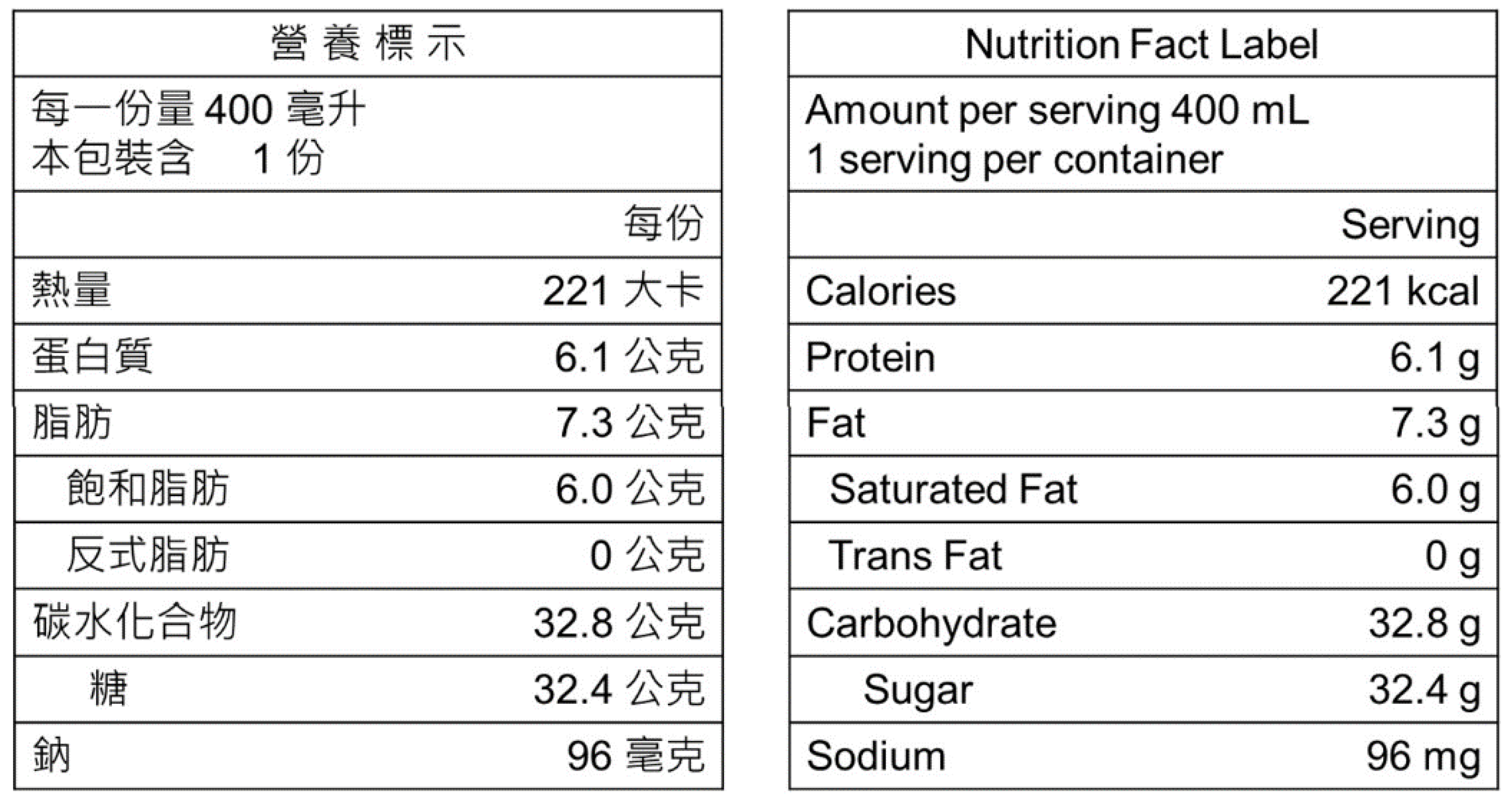
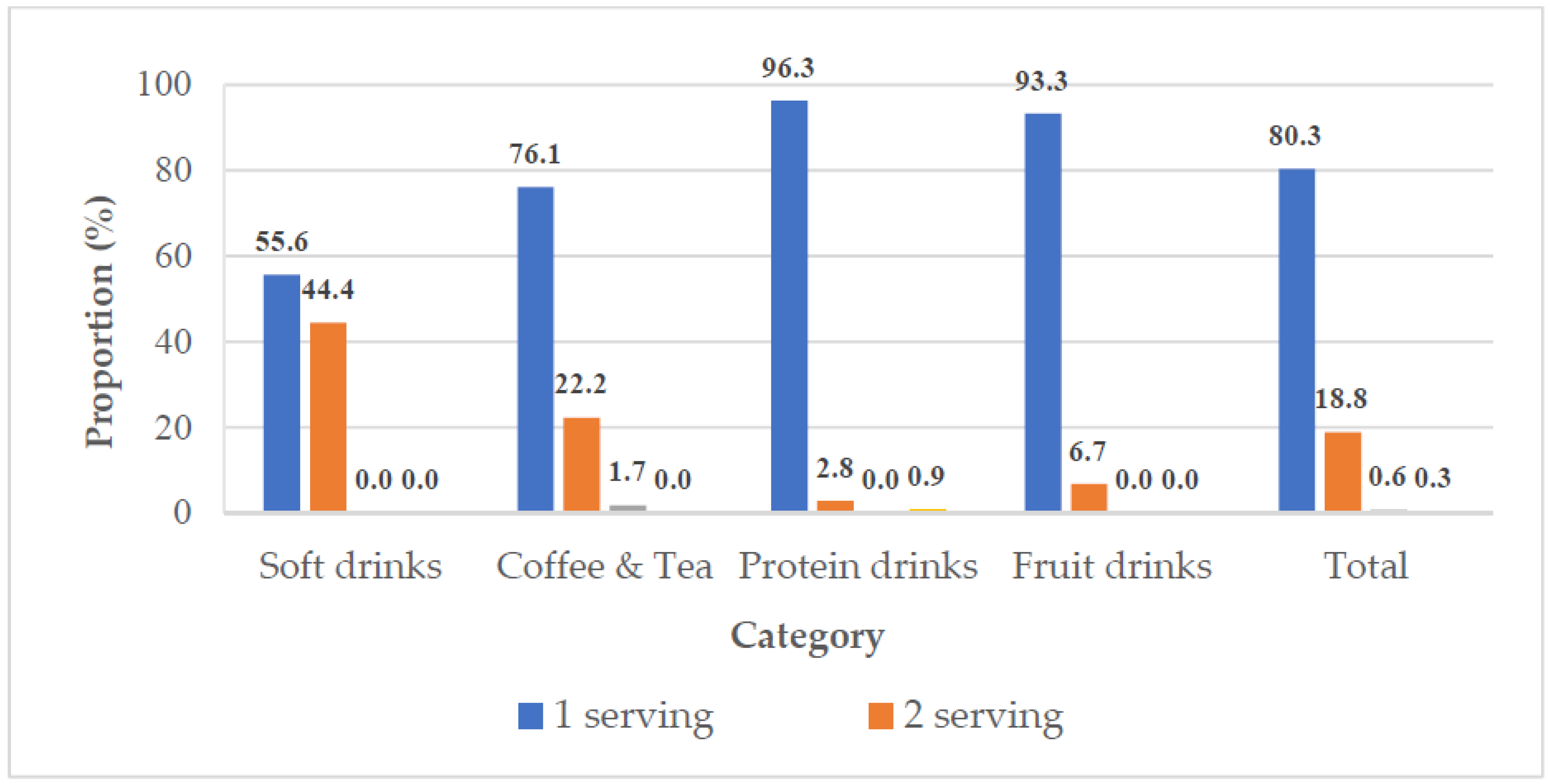
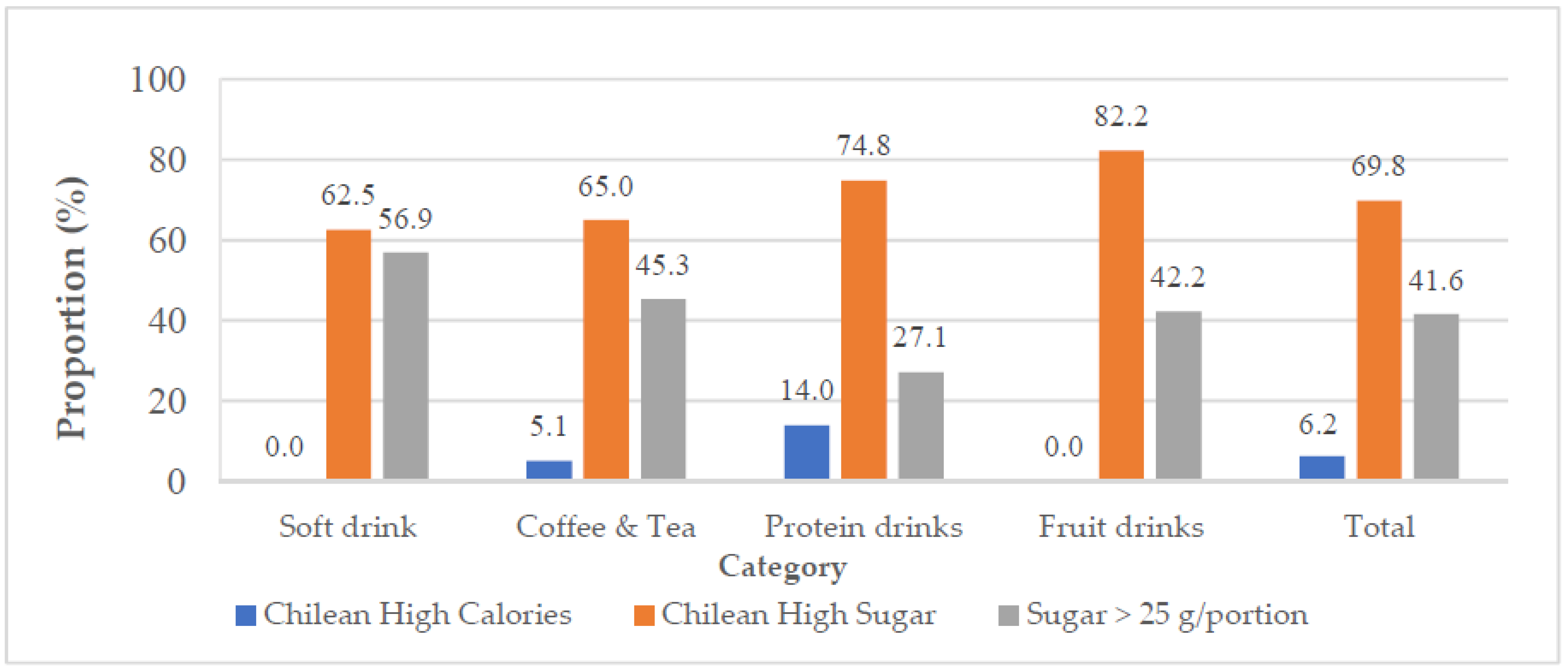
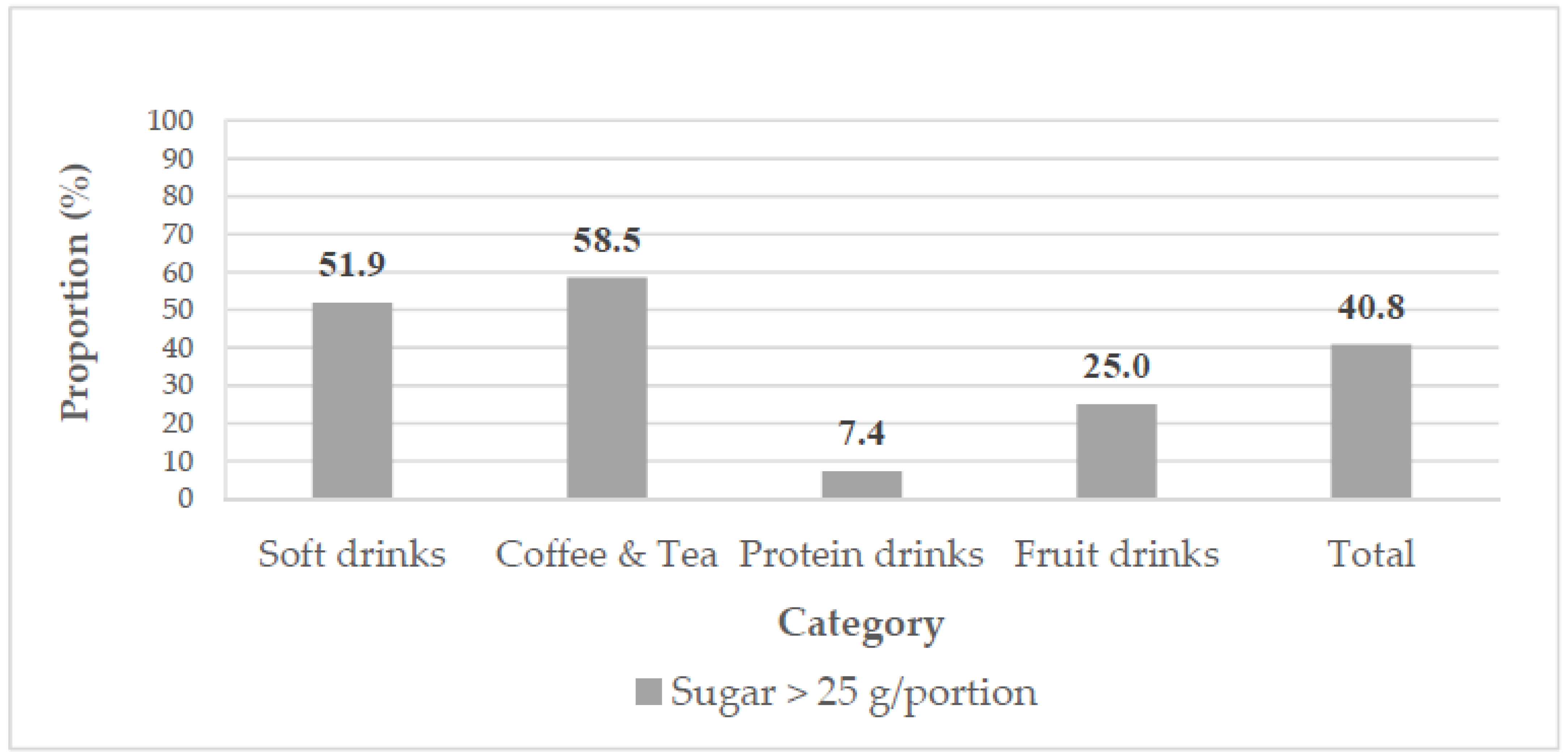
| Coding Content | Coding Standard |
|---|---|
| General information | Product name, brand name |
| Beverage category | Soft drink, coffee and tea, protein drink, fruit drink |
| Portion size | Total volume of drink |
| Nutrition fact label | Serving size; number of servings; calories; and protein, total fat, saturated fat, carbohydrate, sugar, and sodium contents |
| Energy | Sugar | Carbohydrates | Protein | Fat | Saturated | Sodium | |
|---|---|---|---|---|---|---|---|
| (kcal) | (g) | (g) | (g) | (g) | Fat (g) | (mg) | |
| Total | 116 (84.2–160.0) | 21.0 (15.5–27.0) | 22.8 (17.5–30.0) | 1.2 (0.0–4.6) | 0.6 (0.0–3.9) | 0.2 (0.0–2.1) | 5.20 (28.0–97.0) |
| Soft drinks | 92.2 (68.9–121.5) c | 21.7 (16.0–29.8) | 22.7 (17.3–30.3) | 0.0 (0.0–0.0) c | 0 c (0.0–0.0) c | 0 (0.0–0.0) b | 33.0 (18.5–76.3) b |
| Coffee and Tea | 115.0 (84.6–172.1) b | 21.0 (16.7–26.1) | 23.0 (18.1–29.0) | 1.3 (0.0–3.9) b | 2.0 (0.0–4.7) b | 1.2 (0.0–3.8) b | 69.0 (34.5–102.5) b |
| Protein drinks | 141.0 (110.0–187.0) a | 20.5 (12.4–25.7) | 22.0 (16.7–30.0) | 5.2 (3.6–6.4) a | 3.8 (2.2–5.6) a | 1.4 (0.6–2.6) a | 68.0 (30.0–106.0) a |
| Fruit drinks | 96.0 (67.9–145.7) bc | 21.8 (14.6–34.5) | 24.0 (16.9–36.8) | 0.0 (0.0–0.5) c | 0.0 (0.0–0.0) c | 0.0 (0.0) b | 38.0 (26.0–64.0) b |
| p value | <0.001 ** | 0.09 | 0.69 | <0.001 ** | <0.01 * | <0.001 ** | <0.001 * |
| N (%) | Serving Size (mL) | Portion Size (mL) | p Value 3 | |||
|---|---|---|---|---|---|---|
| Median (Range) | CV % | Median (Range) | CV % | |||
| Soft drinks | 72 (21.1) | 300.0 (165.0–600.0) a | 19.0 | 337.5 (192.0–600.0) a | 33.6 | <0.001 |
| Coffee and Tea | 117 (34.3) | 275.0 (100.0–600.0) b | 25.1 | 300.0 (150.0–600.0) b | 35.9 | <0.001 |
| Protein drinks | 107 (31.4) | 250.0 (50.0–450.0) c | 36.7 | 250.0 (100.0–517.0) c | 38.3 | 0.125 |
| Fruit drinks p value 4 | 45 (13.2) | 250.0 (125.0–500.0) c <0.001 | 36.5 | 250.0 (125.0–580.0) c < 0.001 | 42.7 | 0.250 |
| Energy (kcal) | Sugar (g) | ||||
|---|---|---|---|---|---|
| n | Per Serving | Per Portion | Per Serving | Per Portion | |
| Soft drinks | |||||
| 1 serving | 40 | 102.0 (78.0–131.8) | 102.0 (78.0–131.8) | 24.7 (18.9–31.8) | 24.7 (18.9–31.8) |
| >1 serving | 32 | 80.20 (50.0–107.0) | 160.4 (100.0–214.0) | 19.8 (12.0–26.0) | 39.6 (24.1–52.0) |
| p value | 0.003 * | <0.001 ** | 0.006 * | <0.001 ** | |
| Coffee and Tea | |||||
| 1 serving | 89 | 138.0 (95.8–192.0) | 138.0 (95.8–192.0) | 21.8 (17.4–27.0) | 21.8 (17.4–27.0) |
| >1 serving | 28 | 82.4 (58.2–113.3) | 180.0 (148.4–227.8) | 19.8 (12.7–22.4) | 39.7 (30.4–45.2) |
| p value | <0.001 ** | 0.002 * | 0.020 * | <0.001 ** | |
| Protein drinks | |||||
| 1 serving | 103 | 141.0 (109.0–188.8) | 141.0 (109.0–188.8) | 20.4 (12.4–25.7) | 20.4 (12.4–25.7) |
| >1 serving | 4 | 139.0 (124.5–153.5) | 304.0 (268.0–1000.0) | 21.7 (14.2–27.3) | 43.4 (28.5–228.6) |
| p value | 0.850 | 0.001 * | 0.599 | 0.006 * | |
| Fruit drinks | |||||
| 1 serving | 42 | 95.0 (68.4–148.8) | 95.0 (68.4–148.8) | 21.5 (15.2–34.9) | 21.5 (15.2–34.9) |
| >1 serving | 3 | 116.0 (90.6–116.5) | 232.0 (181.0–233.0) | 25.0 (19.3–26.3) | 50.0 (38.5–52.5) |
| p value | 1.000 | 0.026 * | 0.964 | 0.031 * | |
| Categories | Energy (kcal) | Sugar (g) | ||
|---|---|---|---|---|
| Per 100 mL | Per Portion | Per 100 mL | Per Portion | |
| Soft drinks | 32.4 (26.1–41.1) c | 119.5 (89.7–161.7) a | 7.7 (6.1–10.0) bc | 29.0 (21.2–39.9) a |
| Coffee and Tea | 40.0 (32.8–53.1) b | 148.4 (99.0–200.0) a | 7.4 (6.5–8.1) c | 24.5 (18.2–30.0) ab |
| Protein drinks | 59.5 (52.0–65.2) a | 141.6 (110.0–193.0) a | 8.3 (5.2–10.2) b | 20.8 (13.2–26.4) b |
| Fruit drinks | 43.0 (37.4–46.4) b | 96.0 (71.5–153.6) b | 9.8 (8.4–10.6) a | 22.0 (16.1–35.6) b |
| p value | <0.001 ** | <0.001 ** | <0.001 ** | <0.001 ** |
Publisher’s Note: MDPI stays neutral with regard to jurisdictional claims in published maps and institutional affiliations. |
© 2022 by the authors. Licensee MDPI, Basel, Switzerland. This article is an open access article distributed under the terms and conditions of the Creative Commons Attribution (CC BY) license (https://creativecommons.org/licenses/by/4.0/).
Share and Cite
Yen, C.; Huang, Y.-L.; Chung, M.; Chen, Y.-C. Sugar Content and Warning Criteria Evaluation for Popular Sugar-Sweetened Beverages in Taipei, Taiwan. Nutrients 2022, 14, 3339. https://doi.org/10.3390/nu14163339
Yen C, Huang Y-L, Chung M, Chen Y-C. Sugar Content and Warning Criteria Evaluation for Popular Sugar-Sweetened Beverages in Taipei, Taiwan. Nutrients. 2022; 14(16):3339. https://doi.org/10.3390/nu14163339
Chicago/Turabian StyleYen, Chieh, Ya-Li Huang, Mei Chung, and Yi-Chun Chen. 2022. "Sugar Content and Warning Criteria Evaluation for Popular Sugar-Sweetened Beverages in Taipei, Taiwan" Nutrients 14, no. 16: 3339. https://doi.org/10.3390/nu14163339
APA StyleYen, C., Huang, Y.-L., Chung, M., & Chen, Y.-C. (2022). Sugar Content and Warning Criteria Evaluation for Popular Sugar-Sweetened Beverages in Taipei, Taiwan. Nutrients, 14(16), 3339. https://doi.org/10.3390/nu14163339







